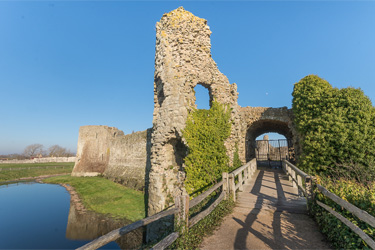
Pevensey Castle, East Sussex
UK IMAGES and REFERENCE
Pevensey Castle in East Sussex
Pevensey Castle is a Norman castle built within the Roman fort of Anderida, sometimes referred to as Anderitum, in East Sussex, and was the landing place of William the Conqueror's invading army in 1066. The fort, which was started in about AD 290, and castle have played their part in British history ever since. The Roman fort was built as part of the defences of the Saxon shore and the site was not ready to oppose William the Conqueror when he landed at Pevensey Bay. When the Norman army landed they found the fort unmanned so were able to immediately consolidate their position. William the Conqueror realised its strategic importance and gave it to his brother, Robert, Count of Mortain who set about building the castle. He began with a great square castle keep and a huge, strong gatehouse.
Since those times, Pevensey Castle has had a varied history and was subject to various sieges particularly in medieval times. A rebellion by William Rufus and his forces in 1088, and following the Battle of Lewes in 1265 Pevensey Castle was besieged by supporters of Simon du Montford. In 1377 the French attacked Pevensey Castle during the Hundred Years War but were repulsed by the Earl of Salisbury and Sir John Montagu with their 500 troops. The castle even played host to Scotland's King James I when King Henry V sent him there as hostage in 1415. Much later, in World War 2 the Home Guard were based there as well as troops to protect the coast in case of invasion. Some of the WW2 defences that were carefully built can still be seen. For example, pillboxes were cleverly built into the walls using local stone and materials so that only the gun openings were seen.
Copyright, licence, research and article source information.
Reproduced and/or adapted for interest and educational purposes.
